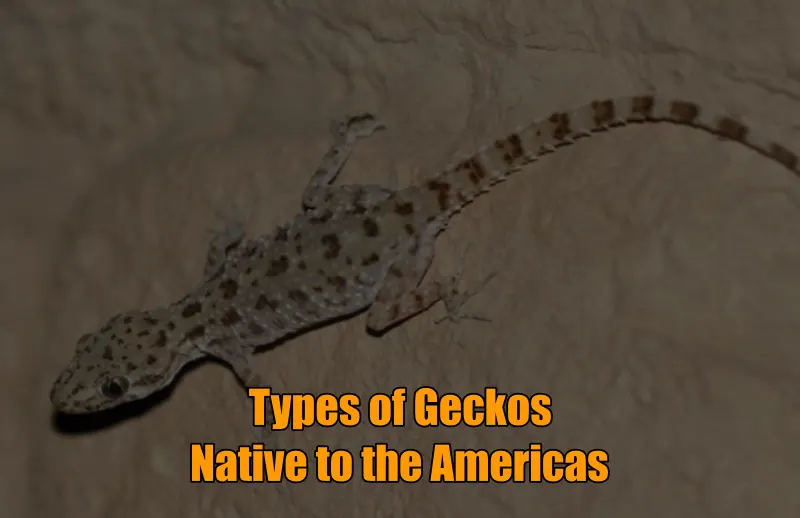Geckos are small, scaly, and often colorful lizards found in a wide range of habitats, from rainforests to deserts. They have incredible adaptations that make them better able to survive in harsh and unfavorable environmental conditions around the world. Have you ever wondered about geckos in America? In this blog post, I will introduce you to some of the gecko species found in America. So here is the list of 15 types of geckos native to America.
15 Types of Geckos Native to the Americas
1. Western Banded Gecko
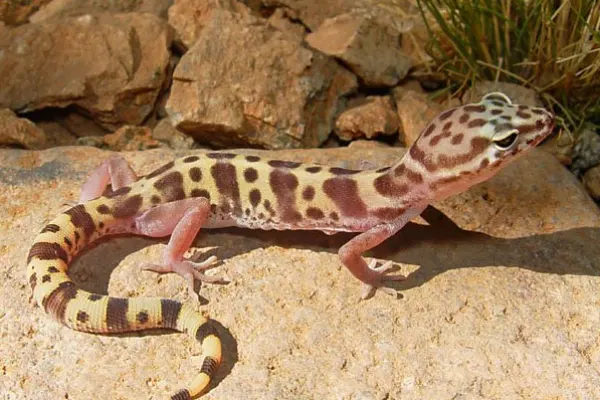
| Scientific name | Coleonyx variegatus |
| Size | 4 to 6 inches |
| Habitat | creosote bush and sagebrush desert, pinyon-juniper woodland |
| Geographical location | Arizona, Southern California, Southwestern New Mexico, Nevada and Utah |
These are some of the most beautiful lizards in the world. The Western Banded Gecko is a sandy-colored lizard that has a very attractive appearance. These geckos are very active at night and are very secretive in nature.
This is the most widespread gecko species in North America. They are pinkish to yellowish tan with darker bands and splotches. They can grow up to 4 to 6 inches.
2. Reticulate Banded Gecko
| Scientific name | Coleonyx reticulatus |
| Size | 6.5 inches |
| Habitat | Semi Arid and rocky areas |
| Geographical location | United States and Mexico |
Reticulate-banded gecko or reticulated gecko are some of the common names of the gecko Coleonyx reticulatus. This threatened species is commonly found in the United States and Mexico. This gecko’s appearance can grab your attention so easily.
They are pinkish-brown in color with black or brown spots. This nocturnal species is sometimes mistaken for a leopard gecko. These small geckos of size 6.5 inches mostly prefer semi-arid and rocky regions.
3. Rough Tailed Gecko
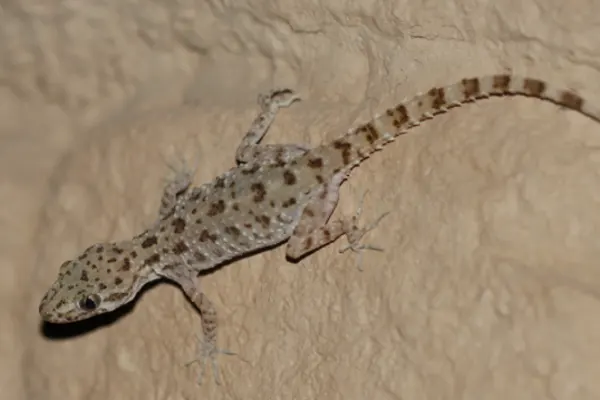
| Scientific name | Cyrtopodion scabrum |
| Size | 12 cm |
| Habitat | Desert and Stony landscape |
| Geographical location | Texas and Arizona |
The rough-tailed gecko is another gecko species found in America. These Asian endemic species were recently introduced in Texas and Arizona. These geckos are small with enlarged keeled scales and can grow up to 12 cm.
They feed on a variety of invertebrates, especially small insects. As their name suggests, they primarily prefer rocky and stony habitats.
4. Coastal leaf toed Gecko
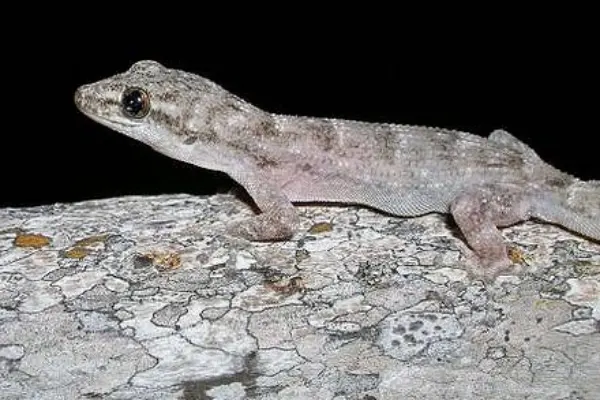
| Scientific name | Phyllodactylus kofordi |
| Size | 46 mm |
| Habitat | dry shrublands and deciduous forests |
| Geographical location | Ecuador, Peru |
Phyllodactylus kofordi, or coastal leaf-toed gecko, is the most common type of gecko found in dry shrublands and deciduous forests. They are the only gecko species in Ecuador that have tubercles on both the dorsal region and the tail.
These lizards are very small and can attain a body length of up to 46 mm. One can easily spot them in the Tumbesian lowlands in southwestern Ecuador and northwestern Peru.
5. Mediterranean Gecko
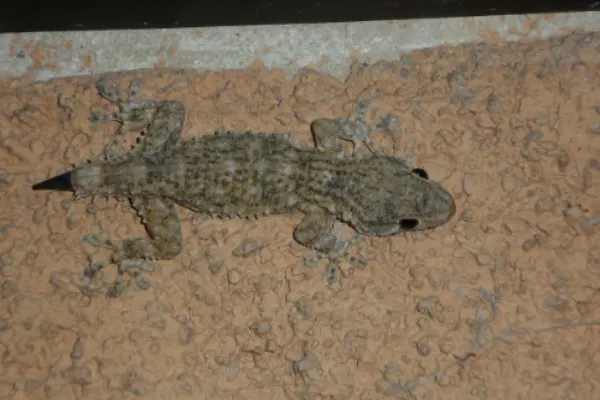
| Scientific name | Hemidactylus turcicus |
| Size | 4 to 5 inches |
| Habitat | university campuses, cemeteries, coastal regions, and shrublands |
| Geographical location | Arizona, California, Louisiana, Florida, Alabama, and Texas |
The next gecko species we have on our list is Mediterranean gecko and Hemidactylus turcicus. This Mediterranean species is commonly found all across the world, including in Southern Europe, Northern Africa, the African Peninsula, Arizona, California, Louisiana, Florida, Alabama, and Texas.
They are small, with a body size of 4 to 5 inches. These house geckos are insectivorous and feed on a variety of insects like moths, small roaches, etc. They are grayish brown in color with a white underside.
6. Texas Banded Gecko
| Scientific name | Coleonyx brevis |
| Size | 10 cm |
| Habitat | Semi Arid regions |
| Geographical location | Southeastern New Mexico, in the United States, and in Chihuahua, Coahuila, Nuevo León, and Durango in Mexico |
Another banded gecko species we have on our list is the Texas banded gecko. These terrestrial geckos have quite a distinct appearance. They are brownish in color, with yellow bands all throughout their body and black spots on the bands.
These nocturnal lizards are commonly found in Southeastern New Mexico, in the United States, and in Chihuahua, Coahuila, Nuevo León, and Durango, Mexico. They are carnivorous, mostly feed on arthropods, and primarily prefer semiarid regions.
7. Ashy Gecko
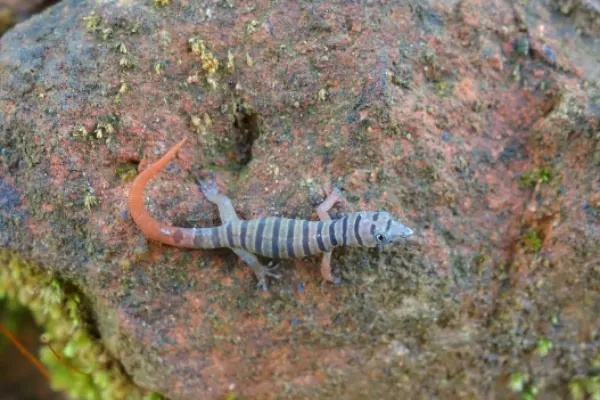
| Scientific name | Sphaerodactylus elegans |
| Size | 2.7 to 2.8 inches |
| Habitat | No information |
| Geographical location | Cuba (including Isla de la Juventud) and Hispaniola (Haiti, including Gonâve Island and Les Cayemites, and the Dominican Republic) |
Another North American species we included is the ashy gecko. Ashy gecko, or Sphaerodactylus elegans, is commonly found in Cuba and Hispaniola. These lizards are very appealing due to their striking appearance.
They exhibit a variety of colors; their head is blue, and then their midsection is green with a red tail, and black horizontal stripes are present all over the body. They are very good climbers, and it is difficult to distinguish between males and females.
8. Fantastic least gecko
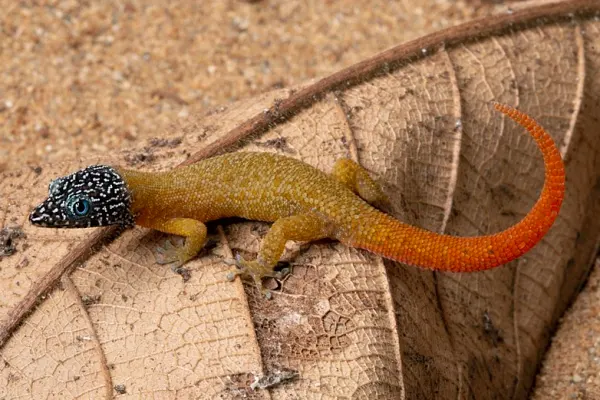
| Scientific name | Sphaerodactylus fantasticus |
| Size | 28-29 mm |
| Habitat | mesic and xeric forests, beaches, hillsides ,and houses |
| Geographical location | the Caribbean, on the islands of Dominica, Montserrat, and the Guadeloupe archipelago |
Just like their name, fantastic least gecko are very distinct in terms of appearance. This sexually dimorphic species varies a lot in color. They are usually brown with a dark-colored head and an orangish tail.
These terrestrial species are native to the Caribbean, on the islands of Dominica, Montserrat, and the Guadeloupe archipelago. They exist in a wide range of habitats, including mesic and xeric forests, beaches, hillsides, and houses.
9. Florida reef gecko
| Scientific name | Sphaerodactylus notatus |
| Size | 2 to 2.25 inches |
| Habitat | pinelands, hammocks, and vacant lots |
| Geographical location | Dry Tortugas, Florida Keys, and southeastern mainland Florida |
Sphaerodactylus notatus, commonly known as the Florida Reef Gecko or brown speckled sphaero, belongs to the family Sphaerodactylidae. They are one of the smallest geckos and hardly attain a size of 2 to 2.25 inches.
They are greenish-brown in color with black spots all over the body. This Florida and Caribbean native species primarily feed on insects and spiders.
10. Big-scaled dwarf gecko
| Scientific name | Sphaerodactylus macrolepis |
| Size | 12 to 27 mm |
| Habitat | dry, arid climates like rocky outcroppings |
| Geographical location | islands in the Caribbean such as Puerto Rico and the US Virgin Islands |
Sexual dimorphism is very common in this species. Males tend to be larger than females. The big-scaled least gecko is the other common name of Sphaerodactylus macrolepis. It is small, with 12 to 27 mm of body length.
They are brownish-yellow in color with dark brown blotches. They prefer dry and arid climates. It mostly feeds on tiny arthropods such as springtails and drosophila. They are commonly found on islands in the Caribbean, such as Puerto Rico and the US Virgin Islands.
11. Ocellated gecko
| Scientific name | Sphaerodactylus argus |
| Size | 10-11 cm |
| Habitat | Primary and secondary forests, in humid microclimates, in tree trunks, old houses, deserted buildings and even in piles of garbage that are shaded and wet |
| Geographical location | Mexico, Nicaragua, Costa Rica, Jamaica, Cuba, and the Bahamas |
Ocellated gecko are commonly called so due to the presence of eyelike spots along the body of adults. Adults are brown in color and are covered in round, eyelike markings. One can easily find them in Mexico, Nicaragua, Costa Rica, Jamaica, Cuba, and the Bahamas.
They are oviparous and feed on insects and small invertebrates. It inhabit a wide range of habitats, like primary and secondary forests, humid microclimates, tree trunks, old houses, deserted buildings, and even piles of garbage that are shaded and wet.
12. Tropical house gecko
| Scientific name | Hemidactylus mabouia |
| Size | 12.7 cm |
| Habitat | Sandy and scrubby areas |
| Geographical location | Brazil, Colombia, Cuba, Dominica, Ecuador, Grenada, Guadeloupe |
Tropical house gecko, Afro-American house gecko, or Cosmopolitan house gecko is another gecko found in America. This species of gecko has the ability to vocalize. These nocturnal animals are voracious feeders of flying and crawling insects.
It can attain a length of up to 12.7 cm. They are light brown to darker brown in color, with black spots on their tails. They are common in Sub-Saharan Africa, North, Central, and South America, and the Caribbean.
13. Yellow headed Gecko
| Scientific name | Gonatodes albogularis |
| Size | 69 to 90 mm |
| Habitat | tropical dry and humid primary and secondary forests and open areas |
| Geographical location | Central and South America, Cuba, Hispaniola and Jamaica |
Yellow headed Gecko are diurnal terrestrial gecko that are sexually dimorphic. Males of this species have yellow head with blue body whereas females are greyish white with light brown head.
These geckos have ability to differentiate between brightness. They are commonly found in Central and South America, Cuba, Hispaniola and Jamaica. They are very aggressive in nature and use their coloration for mating display.
14. South American gecko
| Scientific name | Gonatodes eladioi |
| Size | 3.4 cm |
| Habitat | Forest margins |
| Geographical location | Brazil |
Gonatodes eladioi is a species of gecko in the family Sphaerodactylidae that is endemic to Brazil. They are small lizards with a size of 3.4 cm. They have characteristic vertebral stripes that run along the entire body.
These diurnal geckos are brownish gray and can be found in forest margins and edges.
15. South American marked gecko

| Scientific name | Homonota fasciata |
| Size | No information |
| Habitat | Deciduous forest and desert scrublands |
| Geographical location | Bolivia and Argentina |
The last gecko species we have on our list is the South American marked gecko. As their name suggests, they are commonly found in Bolivia and Argentina. These geckos are small and primarily prefer deciduous forests and desert scrublands.
The reticulated band pattern on their brownish-gray bodies makes them distinct. Their tails have large imbricated scales as compared to other body parts.
List of Geckos Native to Florida
- White-spotted wall gecko
- Flat-tailed house gecko
- Tokay gecko
- Bibron’s thick-toed gecko
- Indo-pacific gecko
- Madagascar giant day gecko
Here we conclude our article on Geckos in America. Geckos are common yet distinctive organisms that exist in many color shades. In America, a lot of gecko species are present. We included 15 of them in this article. I hope you like this article. We will be back with another article soon.
Also Read:

Being a zoology student I’m always been fascinated toward animals especially insects. I love to do research and learn about different animals. As a writer I want to share my thoughts about nature through my articles. Apart from this you can find me exploring the new places and voice notes.
